Industry LTI rate falls to record-low 0.34 in 2011, ISP data shows
Drilling contractors reported no fatalities offshore last year, plus improved performance in recordable and lost-time incidents and fatalities
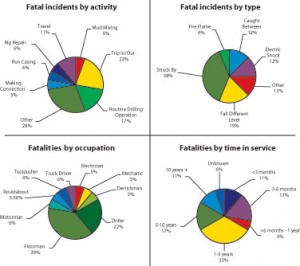
The drilling industry’s worldwide lost-time incidence (LTI) rate dropped to a record low of 0.34 in 2011, an 11% improvement over the rate of 0.38 in 2010. Further, for the first time since the IADC Incident Statistics Program (ISP) was established 50 years ago, participating offshore contractors did not report any fatalities for the year.
Fatalities fell to 18, compared with 32 fatalities in 2010, and the 2011 fatality incidence rate declined from 2010’s 0.014 to 0.007. The recordables rates went from 1.31 to 1.17, which is 11% better than the 2010 report.
Long term, the industry’s efforts toward safety have resulted in the occupational LTI rate falling from more than 14.00 in 1963 to 0.34 in 2011, a 41-fold improvement.
A total of 101 contractors, representing approximately 78% of the worldwide oil and gas drilling rig fleet, participated in the 2011 ISP. The program has tracked safety and accident information for the drilling industry since 1962. The data presented accounts for 504.34 million manhours worked, during which a total of 838 LTIs and 2,947 recordable incidents were reported.
Incidence rates are calculated on incidents per 200,000 manhours. Data is compiled separately for land and offshore operations and for eight geographic regions — US, Europe, Canada, Africa, Middle East, Asia Pacific, Central America/Caribbean and South America.
Fatalities
The industry’s fatalities fell to 18 incidents in 2011, with the incidence rate at 0.007, compared with 2010’s 0.014. Employees with one to five years of service with the company accounted for six fatalities, making up the largest percentage. Fatalities of employees who had less than six months of service totaled five, and one victim had six months to a year of service. Three of the victims had worked for the company between five years to 10 years, and two victims had worked for the company for 10 years or more.
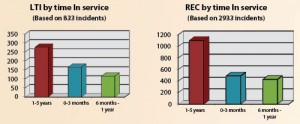
Four fatalities occurred during tripping operations and three during routine drilling operations. Six of the fatalities involved struck-by incidents while three were due to fall-type incidents. Seven of the fatalities occurred to floormen; five were supervisors of drillers or above.

Fatalities by Region
In the European onshore and offshore categories, drilling contractors together worked more than 71.2 million manhours in 2011, with one fatality on land. Offshore workers accounted for 33.46 million manhours while land had 37.76 million manhours.
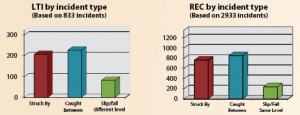
More than 136.71 million manhours were worked together by US land and offshore contractors, who reported a total of 11 fatalities. Onshore operations accounted for 99.24 million manhours worked with 11 fatalities. Offshore contractors worked 37.47 million manhours and had no fatalities.

Canadian contractors had zero fatalities in 2011. Land workers reported 2.99 million manhours, and offshore workers reported 0.83 million manhours for a combined total of accounted for over 3.8 million manhours.

The Central America and Caribbean region also had no fatalities. Combined, contractors accounted for 13.46 million manhours, with land operations working a reported 5.28 million manhours and offshore operations working 8.18 million manhours.

Africa land and offshore together reported 52.94 million manhours with three fatalities. Onshore operations accounted for 24.68 million manhours with three fatalities while offshore had 28.26 million manhours and no fatalities.
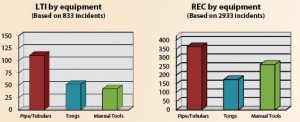
Contractors in the Middle East worked over 103.2 million manhours with one fatal incident. The land division had 71.27 million manhours and one fatality while the offshore division reported 31.94 million manhours and no fatalities.

Asia Pacific accounted for 61.4 million manhours and two fatalities. Offshore had 45.12 million manhours with no fatalities while onshore had 16.28 million manhours and two fatalities.
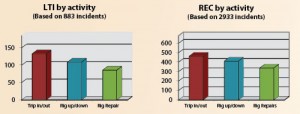
South America made up 61.58 million manhours with no fatalities. Land operations had 42.18 million manhours while offshore operations had 19.40 million manhours.
LTI and Recordable Incidents by Region
Middle East offshore operations significantly improved its LTI rate in 2011 by 48%, going from 0.23 in 2010 to 0.12 last year. The region’s offshore recordables rate also went down by 32%, from 0.77 in 2010 to 0.52 in 2011. In onshore operations in the Middle East, however, the LTI rate worsened by 33% from 0.18 in 2010 to 0.24 last year, but their recordable incidence rate improved slightly from 0.86 in 2010 to 0.83 in 2011.
Africa’s onshore LTI rate also improved. For 2010, the rate was 0.39, which improved by 28% to 0.28 for 2011, and their recordable incidence rate improved by 23% from 1.16 in 2010 to 0.89 in 2011. Offshore workers in this region also saw an improvement in their LTI rate, by 8% from 0.25 in 2010 to 0.23 for 2011, and the offshore recordable incidence rate improved by 13% from 0.91 in 2010 to 0.79 in 2011.
In 2010, US land had an LTI rate of 1.02, which improved by 21% to 0.81 in 2011. Their 2010 recordable incidence rate of 3.44 improved by 17% to 2.87 in 2011. Offshore, the LTI rate improved 29% from 0.24 in 2010 to 0.17 in 2011, and their recordable incidence rate improved by 12% from 0.86 in 2010 to 0.76 in 2011.
South America’s onshore LTI rate for 2010 was 0.23, which improved by 26% to 0.17 for 2011, and their recordable incidence rate improved by 21% from 0.94 in 2010 to 0.74 in 2011. The offshore LTI rate went down by 21% from 0.39 in 2010 to 0.31 for 2011. The offshore recordable incidence rate also improved by 15% from 1.03 in 2010 to 0.88 last year.
The LTI rate among Asia Pacific offshore workers improved by 13% from 0.16 in 2010 to 0.14 in 2011, and the total recordable incidence rate improved by 9% from .67 in 2010 to 0.61 last year. Asia Pacific land workers’ LTI rate, however, worsened by 78% from 0.18 in 2010 to 0.32 in 2011, and their recordable incidence rate worsened 9% from 0.91 in 2010 to 0.99 last year.
Central America and Caribbean’s land 2010 LTI rate of 0.48 improved by 38% to 0.30 for 2011, but their recordable incidence rate of 0.89 for 2010 worsened by 19% to 1.06 for 2011. Offshore, Central America and Caribbean’s LTI rate worsened by 40%, going from 0.05 in 2010 to 0.07 in 2011. Their recordable incidence rate also worsened by 40% from 0.42 in 2010 to 0.59 for 2011.
In the European region, the offshore 2011 LTI rate worsened by 29% to 0.27, from 0.21 in 2010, and the 2011 recordable incidence rate also worsened 8% from 0.74 to 0.80. Europe onshore’s LTI rate also worsened by 32%, from 0.22 in 2010 to 0.29 in 2011, and their 2011 recordable incidence rate worsened by 29% from 0.31 to 0.40.
Canada land’s LTI rate for 2010 was 0.35, which more than tripled to 1.07 in 2011, and its recordable incidence rate of 2.29 worsened by 69% to 3.88 in 2011. Canada offshore saw a 2011 LTI rate of 0.24 worsen by 26% from 0.19 in 2010 and a recordable incidence rate of 0.48 in 2011 improve by 58% from 1.14 in 2010.
Other ISP Findings
• By occupation, the floorman position suffered the largest percentage of injuries, similar to previous years.
• By body part, fingers remained the most vulnerable part of the body.
• By incident type, caught-between incidents accounted for the most incidents and was closely followed by struck-by injuries.
• By equipment, pipes/tubulars was the equipment category responsible for the most LTIs and recordable incidents.
• By activity, tripping in/out involved the most lost-time and recordable injuries.
• By location, by far the most injuries in drilling operations occurred on the rig floor.
• By time in service, employees with between one to five years of service had the most LTIs and recordables, followed by employees with six months to one year of service.
• By time of day, the most LTI and recordable incidents occurred between 09:00 to 16:00 hours.
• By month, June accounted for the most LTIs while August accounted for the most recordables.
Conclusion
Overall, most industry incidence rates improved in 2011, even with the increase in industry activity. Fingers remain the most vulnerable part of the body, and most injuries in drilling operations are still occurring on the rig floor, according to the available reports.
For more information about the IADC Incident Statistics Program or to participate, please visit the IADC website.




